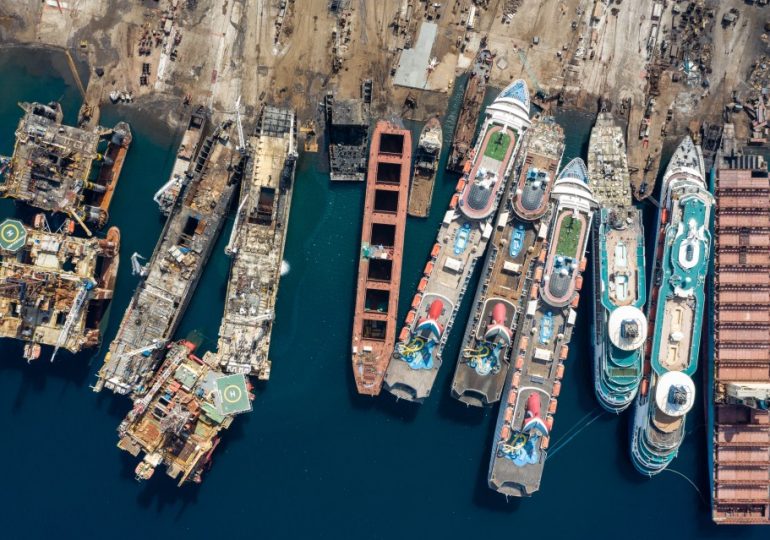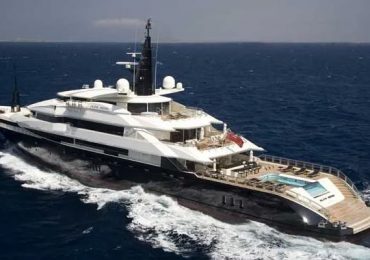WELCOME to the place where over 670 abandoned ships have gone to die including giant multi-million pound cruises.
The Aliağa shipyard in western Turkey is one of the largest ship recycling facilities in Europe and sees pleasure vessels stripped apart and left to rot everyday.
GettyThe aerial view of the shipyard at Aliağa recycling port in Turkey[/caption]
GettyA shipbreaker works hard to dismantle a giant ship for anything worth enough money to sell on[/caption]
ReutersLines of decommissioned cruises sit on the shoreline after being stripped for parts and left to rot[/caption]
Sat on the ports of Izmir the cruise ship graveyard is constantly full of glamorous boats now in a state of disrepair.
After being decommissioned and no longer deemed fit for service the pricey ships are delivered to the ship breaking yard where workers get down to business tearing them apart.
Footage online shows the giant cruise liners stacked up one by one either waiting to be dismantled or already stripped for all they’re worth.
The process starts with the ship’s captains beaching their beloved boats at the yard in Turkey before they undergo a thorough inspection.
Then the crew gets to work dismantling the ships and removing any material that can be sold on for profit.
The recovered metals from a ship can bring in up to $4million (£3.15million) in profits when everything has been recycled for future construction or sold on.
Around 2,500 shipbreakers work on a single boat, according to reports, as they battle against the tricky circumstances and sheer size of many of the ships to empty them mostly by hand.
Emre Aras, a project manager at Avsar Gemi Sokum shipyard said: “I can easily say that cruise vessels are the hardest vessel type to dismantle because, you know, there are hundreds of rooms on board.”
Workers spend hours ripping apart desolate swimming pools, destroying former gym rooms and stripping walls, windows, floors, and handrails so the ship is down to its bare bones.
Then once the decks are clear the workers begin to tear away at the side of the boats, taking away huge chunks one piece at a time until just the shells remain intact.
But its not just fancy cruise ships that go to Aliağa to waste away as drill ships, ferries, offshore rigs and giant tankers are all also stripped for their valuable parts.
The Aliağa yard is seen as the second largest graveyard for ships, but top spot goes to Alang, in India’s Gulf of Khambhat, which recycles more than half of the world’s decommissioned cruise ships alone.
Dangerous job
Alongside the time and manpower it takes to fully empty a single ship the ship is also seen as one of the most dangerous on the planet.
The workers involved are in a constant risk of danger when they arrive at the shipyard each day for a number of reasons.
Nicola Mulinaris, a communication and policy officer at NGO Shipbreaking Platform told Insider that workers need to be wary not to fall off the ships or get hit by falling objects.
They also deal with machinery that can lead to some nasty injuries if used incorrectly such as blow torches or drills.
But the chemical side of the job is the biggest threat for the staff.
The amount of toxic gas onboard an abandoned ship can be lethal in high doses and inhaling any amount the dangerous gas can lead to major health scares in the future.
Oil fumes, paint, any remaining fuel and burning plastic are all the biggest silent killers onboard a battered ship.
On top of all of that, shipbreakers work in extreme weather conditions all year round and are always at risk at making very expensive mistakes.
A mistake can be costly in most industries but especially in one like ship recycling.
Causing damage to the environment can draw in heavy fines from environmental agencies and millions of pounds worth of old ship parts can become unusable if there taken off in a dodgy condition.
One of the abandoned ships is the MS Astor that first hit the waters in 1986 and carried passengers on cruises for 34 years before arriving in a graveyard of ships destined for the scrapyard.
One image shows a retro bar, frozen in time, with drinks still on the tables.
In another harrowing picture, a deep empty crater sits where the pool once was and deck chairs are assembled beside.
A third image shows a flashy gym with an incredible sea view – where the equipment is now gathering dust as it hasn’t been used in years.
The incredible theatre was also captured in a snap showing many empty chairs still in place to watch a performance that will never happen.
The recovered metals from a ship can bring in up to $4million (£3.15million) in profitsGetty
ReutersLuxury cruises turn up the shipyard to die as they wait until workers begin to tear them apart and leave them rotting and empty[/caption]
Leave a comment








